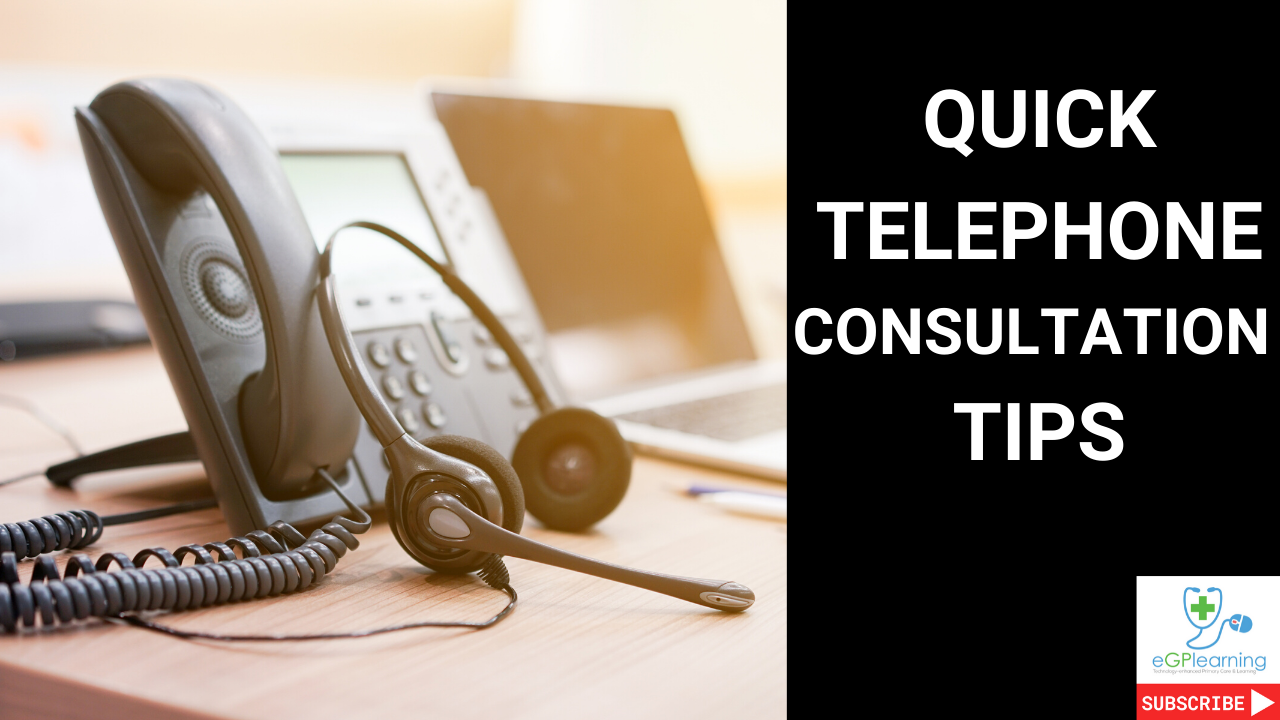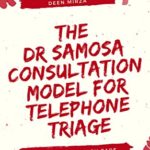Telephone Consultation tips for GPs and primary care
Many clinicians are looking for support with how to do telephone and video consultations. The tech is a limitation but these consultations are a skill as well. These tips should help you with telephone consultations to get started..
If you want a more detailed but short read see Dr SAMOSA by Deen Mirza. It took me about half an hour to read and assimilate and is constructive advice to help any clinician. Also available as an ebook and great for CPD.
If you have the time and want a more detailed read that will give you all the tools to do telephone consultations (apart from the experience) then I highly recommend this book: Telephone triage and consultations by Sally-Anne Pygall – it is everything you need to know.
Both are affiliate links.
However, if you want a five-minute read see below.
Telephone triage tips:
Before you start:
- Use a headset – it will provide better audio both ways (especially if you have a mic) and you hear your own typing less and will have free hands so more likely to document during consult. If using Mitel phone systems then try this one that I use.
- Check the reason for the call – look at the records briefly before you make the phone call, it really helps ie alerts, past medical history, recent contacts etc.
- Limit interruptions – ensure other staff are aware you are on the phone, recommend having screen messages to pass information rather than knocks on the door as it will fluster you and make things longer.
- Establish the mindset of why you are calling. If using to assess the reason first and confirm an appointment is needed, this should be your endpoint. If it is to not see the patient, have routes in place to manage this first and the tools to help you like weblinks (ie nhs.uk or patient.info links, knowledge of which services can deal with appropriate conditions, leaflets etc. If it is just a review, focus on the issue you are reviewing.
- if you have a list with pre-triage information (via admin team or patient-generated) then screen for the cases that require your urgent attention either based on clinical need or likely to need to come down hence get them booked in first like children who most would have a lower tolerance for bringing in.
Consultation
Opening
Confirm who you are speaking with first normally 3 point identification – name, date of birth and address. Check they are somewhere private to talk. If a parent or guardian speaking, confirm who (document) and that you have consent where applicable to speak to them. Use an auto-consult or macro to help document this.
Introduce yourself- be cheerful. It can be tempting on your 20+ call to feel tired but with the lack of non-verbal communication, the tone is all you have left, starting low will more likely make the consultation harder.
This is my standard opener sequence- (we run urgent assessment triage twice daily):
- Hello, I believe you are expecting a call from the practice?
- May I just confirm your name, date of birth and address to confirm I have the right notes?
- Thank you, I am Dr Gandhi from Wellspring, how can I help you with your urgent medical health issue?
Establish the history
Golden half minute – listen to what they are saying, jot down things if needed so you do not lose track.
When they stop check for other things NOW- get the list at the start. Establish what you are dealing with on the call and repeat back to the patient to set expectations.
Clarify the bits you need. The important decision you are making is ‘do I need to see you not’. Your aim should be to answer this question first.
Clarify deeper–if short of breath – what does that mean? If not drinking – how much? If they have vomiting, how many times/what/when etc? Be specific.
If the patient is giving wooly answers – go to closed or yes/no questions to get the info you need.
Listen and check for ‘hard’ evidence – the way they breathe, speech flow etc. If able check pulse /stand on foot etc.
Do not feel rushed. Many see telephone consultations as a quicker route. IT can be, however, I still have had 20 min telephone consultations as it was the most effective way of dealing with the patient.
Plan
Summarise and repeat back-it makes a massive difference later.
Repeat for each issue before going to plan.
Explain your plan based on the information they have given.
If you have options state how many first then explain.
‘You said….. So my advice is…..’
Most patients will accept the information you give if you have done the above. Some will want something different. This is where the summarise and repeat back is invaluable as you can refer to this with facts relating to the patient.
Follow up tips
If you need to see the patient arrange it. This decision is normally by 2 minutes I find in patients who speak reasonable English with one or two issues max. Do not take more information to justify bringing the patient in – that can be done when they arrive.
If running an urgent clinic, enquire how long it will take the patient to arrive and offer an appropriate appointment. If a patient needs seeing do not let capacity affect clinical safety and your comfort with the advice you are giving. This is not always easy. Have a mechanism for overflow appointments.
Establish the boundaries of convenience vs urgency. It is great when both work but do not be afraid to challenge issues relating to patient need vs want. Fall back on your clarification and summarising to help.
If you are not planning on seeing the patient that day – give plan and safety net. Be specific. Document this clearly.
Do not be woolly. Call back if worse is poor advice – what does worse mean?
Use auto consultation/macros/text expanders to help with this. You are welcome to use the eGPlearning text expander available here
If you are not seeing the patient, use text message links to help send information. AccuRx is great for this, especially with integrated NHS.uk links.
Electronic prescription service (EPS4) means physical prescriptions is not normally an issue. Other items like med3s, investigation paperwork can often be collected later.
Bloods, investigations etc arrange as your process. Give patients details on how to arrange.
Housekeeping
Do not do something you are not comfortable with. Similarly, if you are confident with your plan, explain this and your reasoning based on the information provided by the patient. Doing this will reduce you feeling pressured to offer a face to face appointment when it is not needed.
Take breaks- decision fatigue is an issue. Grab a drink, nip to the loo, few burpees every three calls – whatever it takes to keep you sane.
If you are new to telephone assessment then discuss how you feel you did with others. Sense checking makes a massive difference particularly if new to it.
For information on more complex situations like non-english speaking patients, risk of domestic violence see the resources above which explain this in more detail.
⭐Top posts⭐:
??⚕️Dr Gandalf’s essential GP equipment list ??⚕️
?Equipment to record patient consultations for teaching – a guide?
Subscribe to or follow the eGPlearning platform for more videos, app reviews and content to support technology-enhanced primary care and learning.
? Subscribe: https://egplearning.co.uk/subscribe/ ?
Other networks:
? Facebook – https://www.facebook.com/Egplearning/ ??
? Twitter – https://twitter.com/egplearning ?
? Twitter – https://twitter.com/drgandalf52 ?
? Website – https://egplearning.co.uk/ ?️
? Support: https://patreon.com/egplearning ?
Some links may contain affiliate links to help support eGPlearning see our disclaimer at https://egplearning.co.uk/contact/dis…



13 replies on “Quick telephone consultation tips for primary care”
Call back if worse is NOT poor advice
Specifying particular reasons to call back presupposes that you understand exactly what is going on and can predict all possible developments.
Call back if at all concerned might be better. Patients and relatives need to be encouraged to pay attention to any indication of deteriorating general condition; these can be non specific so wasting time trying to specify particular things to look out for is poor
Keep it short and those patients who are deteriorating will be able to get through quickly when they call back
Comments based on >30 years experience of telephone usage
Thank you for the comment Tony. I agree it is a broad statement made to focus people on not simply using quick routes which often do not help. It is a fine balance which experience can help with.
Very useful informative guidance for remote consultations
The three-point identification tool could also include other factors which could be more specific to the patient. Some examples are 1. Name a couple of the medications they use 2. Who did they speak to / see on their last visit.
agree, definitely further options like what the banking system uses.
Very good information, thank you. I would like to make a suggestion.
I think it is better to state who you are and where you are calling from, first.
Then go on to say ‘I believe you are expecting a call from the practice?’
Why?
Well, you are asking for personal information at a time when scammers and fraudsters are wild and you may be taking to vulnerable people who are easily intimidated.
It’s also good to confirm that they are speaking from the given address just in case something happens.
I can see your point.
I personally open with the line ‘ I believe you were waiting for a call from the practice’, as a sign that helps people to confirm about the call and give some reassurance.
The challenge is what to do in safeguarding situations which can occur if a person’s phone is being controlled by someone else, or to try and ensure you are speaking with the patient over another person by accident.
Three points of ID should always be asked. Name, DOB, address are common options, date of last consultation, regular medications and allergies are other options.
[…] https://egplearning.co.uk/quick-telephone-consultation-tips-for-primary-care/ […]
very usefull
very useful and informative
Useful and informative thanks
Thank you this is very concise and helpful tips
Very useful